
 Clio Chase is hoping for a quiet season in Sicily with her family. There she can forget all about the enigmatic Duke of Averton and the strange effect he has on her. That is until he unexpectedly arrives, shattering her peace and warning her of trouble…
Clio Chase is hoping for a quiet season in Sicily with her family. There she can forget all about the enigmatic Duke of Averton and the strange effect he has on her. That is until he unexpectedly arrives, shattering her peace and warning her of trouble…
The unsettling attraction is still strong between them, despite the secrets they hide. But as the unknown threat grows, they are thrown together in the most intimate of ways. Clio knows there is only so long she can resist her mysterious duke!
“Amanda McCabe has crafted a spell-binding, sensuous read grounded in Greek mythology. Filled with muses, romance, intrigue, and mystery, this thrill-of-the-hunt Regency historical evokes visions of Aphrodite and Apollo amongst the ton setting. Like any great read, I was sad for it to end!” –The Season on To Catch a Rogue (read full review here!)
Last month I launched the “Muses of Mayfair” trilogy with book one, To Catch a Rogue. Now it’s almost May, and I’m very excited to talk about book two, To Deceive a Duke! (Book three, To Kiss a Count, is out in June). One commenter today will win a signed copy of Duke…
 In Rogue we met the second-eldest Chase Muse, Clio, and saw her clash with the mysterious Duke of Averton. In Duke they meet again, and those sparks fly between them once more–only this time they have an even harder time keeping them contained! They have to learn to work together to save a rare and precious hoard of ancient temple altar silver–but can they do it while also keeping their hands off each other? I think not…
In Rogue we met the second-eldest Chase Muse, Clio, and saw her clash with the mysterious Duke of Averton. In Duke they meet again, and those sparks fly between them once more–only this time they have an even harder time keeping them contained! They have to learn to work together to save a rare and precious hoard of ancient temple altar silver–but can they do it while also keeping their hands off each other? I think not…
After meeting this passionate pair in Rogue, I was very eager to see what was really going on between them. As I made my way through their story they often surprised me–and I’m supposed to be their creator, the director of their story! Ha. They usually paid me no heed and went off on their own rollercoaster ride.
It was the middle of winter when I started writing this book, and I was sick of cold, gray skies. I needed some sun ASAP, even if it was just vicariously! So I sent Clio, the duke, Sir Walter Chase, and his fourth daughter Terpsichore (Cory) off to bright Sicily for an archaeological dig. It was so much fun to read travel and history books (and sometimes historical travel books!) about the island, and imagine being somewhere warm and filled with olive and lemon trees, flowers, beautiful architecture, and historic sites. The ancient city Clio and her family are excavating is based on a real place, Enna, which was colonized by the Greeks in the 6th century BC and became a sort of vacation resort for them. Destroyed during the Second Punic Wars with its inhabitants killed or enslaved, it was buried in a mudslide in the 12th century which preserved an ancient agora, theater, and gorgeous holiday villas under almond and olive orchards. The medieval castle Clio and Averton explore together is based on a real site, as if Clio’s farmhouse where the silver is buried and the silver itself. This altar set is based on the famous “Morgantina silver” now in the Met (a great article about it can be found here, and more info about the history of the Enna province here).
 As we learned in Rogue, Clio is way passionate about what she believes in and is willing to go to great lengths to protect it–but so is the duke. What will happen if they again find themselves at cross purposes? (And I wish I knew where I could get Clio’s blue dress on the cover. It’s certainly impractical for excavation work but it’s so gorgeous!)
As we learned in Rogue, Clio is way passionate about what she believes in and is willing to go to great lengths to protect it–but so is the duke. What will happen if they again find themselves at cross purposes? (And I wish I knew where I could get Clio’s blue dress on the cover. It’s certainly impractical for excavation work but it’s so gorgeous!)
I have lots more info on my website, including some great sources for the history of the era in the History Behind The Book section. And if you don’t win today, you can enter the contest on my website or visit Kwana’s Blog before the end of of today to enter the contest there! (Giveaways galore!)
Where would you have a dream vacation? What are some objects you’ve seen in museums that have captured your imagination? And I have the potential to write more “Muses” books in the future–any ideas for possible settings for them? (I’d love to send Cory, who is an artist, to illustrate some sites in Egypt…). And on a completely unrelated note, how terrific was Small Island on “Masterpiece” last week??? I loved it.
 Happy Tuesday, everyone! If you have some online time on your hands today, come and visit me at the eHarlequin forums. I’ll be talking about the “Muses” all week this week (book 2 of the trilogy, To Deceive a Duke, will be on the shelves in May, and next Tuesday I’ll be here talking about it and giving a copy away!). And I found out that, due to a snafu, the ebook of Countess of Scandal will finally be out on April 30. Yay!
Happy Tuesday, everyone! If you have some online time on your hands today, come and visit me at the eHarlequin forums. I’ll be talking about the “Muses” all week this week (book 2 of the trilogy, To Deceive a Duke, will be on the shelves in May, and next Tuesday I’ll be here talking about it and giving a copy away!). And I found out that, due to a snafu, the ebook of Countess of Scandal will finally be out on April 30. Yay!
Now, last week I blogged about Handel’s Messiah and its big premier in Dublin. This week marks another anniversary for Handel–the date he was interred at Westminster Abbey in 1759. I have one great enjoyment in life that strangely enough I have found non-history geeks and non-history readers think is a bit odd. I enjoy wandering around old cemeteries. I like reading the epitaphs and imagining how the people lived, I like deciphering antique symbols, and I even like visiting the resting places of historic figures I admire. I guess I think that by some kind of osmosis I can communicate with them (though that has never happened, and would scare the bezeesus out of me if it did)! There is no better cemetery for a history buff than Westminster Abbey. It’s full of the great, near-great, famous, and people who just somehow had the pull to get themselves big tombs there when they died but no one knows them now. There are royals galore, scientists, artists of all sorts, politicans, all sorts.
On the Splendors of the Regency tour Diane and I went on a few years ago, we got to go to the Abbey (not as part of the tour, just as something to keep us busy when we first got there). Despite a torrential rainstorm as we tried to leave and my jet-lagged daze, it was an amazing experience just to wander around and find people I “knew” as well as look at the sites I remembered from royal wedding and coronation videos. I stood on top of the marker where Cromwell once was (before Charles II dug him up and hanged him), and cried at the elaborate tomb of Elizabeth I. Here are just a few of the luminaries you can see there:
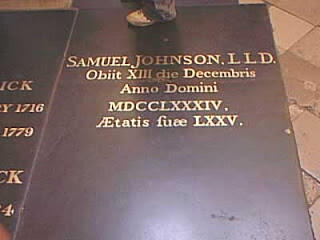 Samuel Johnson, d. 1784 (who happens to be right next to Ben Jonson, d. 1637, and actor David Garrick, d. 1779)
Samuel Johnson, d. 1784 (who happens to be right next to Ben Jonson, d. 1637, and actor David Garrick, d. 1779)
 Henry Purcell (d. 1695) and his wife Francisca
Henry Purcell (d. 1695) and his wife Francisca
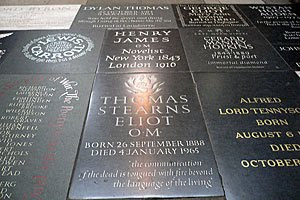 Poets’ Corner, where you can find everyone from Chaucer to Olivier, and memorials to many who are buried elsewhere like Shakespeare and Eliot (it’s quite crowded there)
Poets’ Corner, where you can find everyone from Chaucer to Olivier, and memorials to many who are buried elsewhere like Shakespeare and Eliot (it’s quite crowded there)
 Explorer David Livingstone (d. 1873)
Explorer David Livingstone (d. 1873)
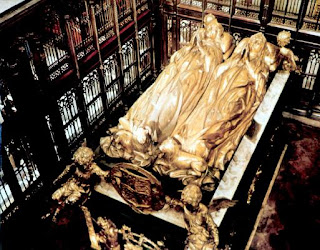 Henry VII and his queen Elizabeth of York (in, appropriately, the Henry VII Chapel)
Henry VII and his queen Elizabeth of York (in, appropriately, the Henry VII Chapel)
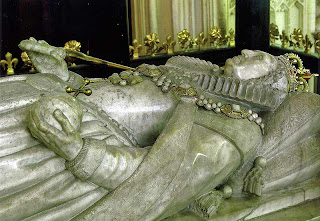 Also in the Henry VII Chapel, his granddaughter Elizabeth I (and Mary I, too, but only Elizabeth gets an effigy)
Also in the Henry VII Chapel, his granddaughter Elizabeth I (and Mary I, too, but only Elizabeth gets an effigy)
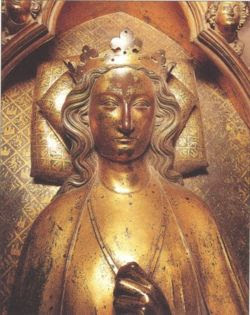 Eleanor of Castile, d. 1290 (I just think this effigy is so beautiful)
Eleanor of Castile, d. 1290 (I just think this effigy is so beautiful)
 Anne of Cleves, the only wife of Henry VIII to be buried at Westminster (d. 1557)
Anne of Cleves, the only wife of Henry VIII to be buried at Westminster (d. 1557)
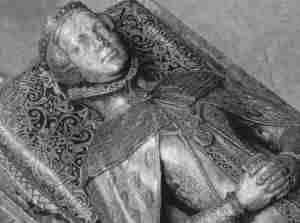 Frances Brandon Grey, Duchess of Suffolk, mother of the unfortunate Jane Grey (her youngest daughter Mary is buried with her)
Frances Brandon Grey, Duchess of Suffolk, mother of the unfortunate Jane Grey (her youngest daughter Mary is buried with her)
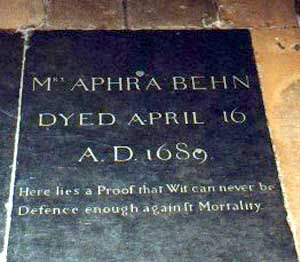 Playwright Aphra Behn (d. 1689). Proof that wit can never be defense against mortality.
Playwright Aphra Behn (d. 1689). Proof that wit can never be defense against mortality.

Margaret Beaufort, mother of Henry VII
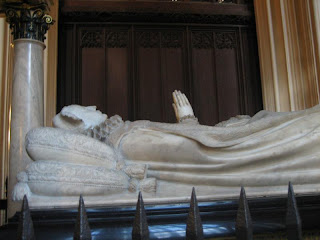 She is right next to her great-granddaughter Mary, Queen of Scots, who has one of the biggest tombs in the place (put up by her son when he became James I)
She is right next to her great-granddaughter Mary, Queen of Scots, who has one of the biggest tombs in the place (put up by her son when he became James I)
 And Elizabeth, Duchess of Northumberland, a famous hostess of her day who died in 1776–I think it’s so gorgeous!
And Elizabeth, Duchess of Northumberland, a famous hostess of her day who died in 1776–I think it’s so gorgeous!
This is just the tiniest tip of the iceberg to the sites found in the Abbey. Have you been there? What are some of your favorites? And if you share my historical hobby, what are some great historical cemeteries you’ve visited?
 Today, April 13, marks the anniversary of the debut of one of the best-known works in classical music, Handel’s Messiah! It was composed in London during the summer of 1741 in just 24 (!!!) days and was premiered in Dublin April 13, 1742. It was afterward revised numerous times by Handel (often to the specifics required by the performing orchestras) and reached its now most-familiar form at a performance to benefit the Foundling Hospital in 1754. It’s still often performed at Christmas and Easter, with the world record for an unbroken sequence of performances held by the Royal Melbourne Philharmonic, which has performed it annually since 1853!
Today, April 13, marks the anniversary of the debut of one of the best-known works in classical music, Handel’s Messiah! It was composed in London during the summer of 1741 in just 24 (!!!) days and was premiered in Dublin April 13, 1742. It was afterward revised numerous times by Handel (often to the specifics required by the performing orchestras) and reached its now most-familiar form at a performance to benefit the Foundling Hospital in 1754. It’s still often performed at Christmas and Easter, with the world record for an unbroken sequence of performances held by the Royal Melbourne Philharmonic, which has performed it annually since 1853!
Messiah is divided into 3 parts which interpret the life of Christ, the birth, miracles, crucifixion, resurrection and ascension, concluding with Christ’s final victory over death and sin. It was premiered as part of a series of charity concerts in Neal’s Music Hall in Fishamble Street near Dublin’s Temple Bar. Right up to the very date of the premiere the performance was plagued by technical difficulties, and the Dean of St. Patrick’s Cathedral, Jonathan Swift (under whose aegis the premiere was to be held) cancelled it for a time. He demanded that the revenue from the concert be promised to local asylums for the mentally ill. The performance was finally held on April 13, and was completely sold out–the managers had to ask ladies not to wear their largest hoops for fear there would be no room for everyone in the hall! Handel led the performance from the harpsichord while his frequent collaborator Matthew Dubourg conducted the orchestra from the podium.
 The soprano aria I know that my Redeemer liveth is often heard today at funerals, and over Handel’s grave in Westminster Abbey his statue holds a score of this very aria. The most popular section heard today is the Hallelujah chorus, which concludes the second of the three parts. In some performances it’s standard for the audience to rise for this piece, which is said to come from its first London performance on March 23, 1743. King George II rose, and so of course the rest of the audience had to follow! Another tale (which may or may not be true) says an assistant found Handel in tears as he was working on the composition and asked him what was wrong. Handel held up the score to this chorus and said “I thought I saw the face of God!”
The soprano aria I know that my Redeemer liveth is often heard today at funerals, and over Handel’s grave in Westminster Abbey his statue holds a score of this very aria. The most popular section heard today is the Hallelujah chorus, which concludes the second of the three parts. In some performances it’s standard for the audience to rise for this piece, which is said to come from its first London performance on March 23, 1743. King George II rose, and so of course the rest of the audience had to follow! Another tale (which may or may not be true) says an assistant found Handel in tears as he was working on the composition and asked him what was wrong. Handel held up the score to this chorus and said “I thought I saw the face of God!”
What are some of your favorite pieces of music from this period (Handel or otherwise!)? Have you heard any memorable performances of Messiah? And do you think it is really possible to write such a thing in 24 days??? (I wish I could write a book in 24 days!)